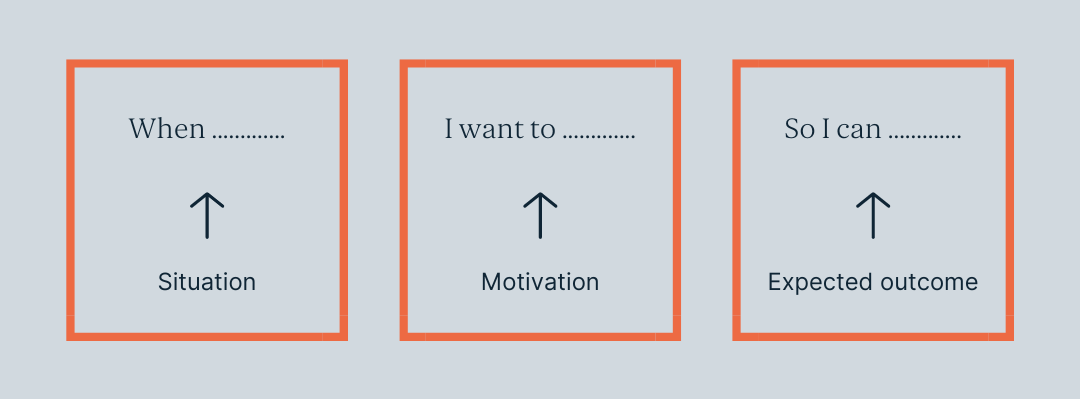How to use the Jobs-to-be-Done framework
Understanding the needs of the users of your digital product is key. Traditional development methods often fail grasping the nuances of these needs. Resulting in a product with a mediocre user experience.
The Jobs-to-be-Done (JTBD) framework is a great solution. It will help you gain deeper insights into your users’ needs. So you can develop products that delight!
Below, a step-by-step guide on how to use the Jobs-to-be-Done framework.
What is the Job-to-be-Done framework?
The main aspect to consider is that The jobs-to-be-done (JTBD) approach removes the focus from the product itself, and places it on the customer. It suggests that customers “hire” products or services to fulfil specific jobs or tasks in their lives. This theory posits that people don’t just buy products, but they “hire” them to accomplish a particular job they need to get done. These jobs are the fundamental reason behind why customers make purchasing decisions.
The theory simply asks, ‘What is the job your product is hired to do?’
Real-world example
A SaaS company offering project management software shifts its focus from task tracking to understanding customers’ job of “efficient team collaboration and project completion.” In the context of remote work and complex projects, their software aids real-time communication, automated alerts, and performance analytics. By emphasising successful project outcomes and improved team dynamics in their messaging, they create a strategy that aligns with customers’ core needs, resulting in user satisfaction and long-term growth.
Understanding your end users is 1 thing, however, finding a product-market for your product is a 2nd.
Every new project at GlobalOrange commences with a comprehensive two-day Product Discovery Workshop. During this workshop, our team of experts in User Experience Design, Product Management, and Technology collaborates with you to precisely outline your vision and objectives. These are then intricately linked to the unmet needs of your end users. The outcomes of the Product Discovery Workshop encompass the following: a profound understanding of the business challenges we aim to address, a grasp of users’ needs and associated advantages, benefits for your company, key success factors for the proposed solutions, potential solution concepts, well-defined key user journeys, and a detailed project development plan.
If you already have found your product-market fit, it is important to measure the product-market fit. This is not a one-time task, but rather an ongoing process that requires continuous monitoring, feedback, and adaptation.

Implementing the JTBD framework: A step-by-step guide
1. Identify the core jobs: begin by identifying the core jobs your customers are trying to get done. This involves extensive research, interviews, surveys, and data analysis to uncover the underlying motivations.
2. Define the dimensions of the jobs: understand the functional, emotional, and social dimension of the jobs. Functional aspects refer to the tasks customers want to accomplish, emotional aspects relate to the feelings associated with those tasks, and social dimensions involve how the task affects relationships or status.
3. Segmentation: segment your market based on the different jobs customers are trying to get done. This allows you to tailor your products and marketing messages to specific customer segments.
4. Evaluate existing solutions: analyse the current products or services customers are using to fulfil these jobs. Identify gaps and areas for improvement.
5. Ideation and Innovation: Brainstorm and ideate innovative solutions that directly address the core jobs identified. This might involve thinking outside the box and exploring new product concepts.
6. Prototype and Test: Create prototypes of the new solutions and test them with your target audience. Gather feedback and iterate on the prototypes to refine the solutions.
7. Message Development: Craft marketing messages that highlight how your product or service fulfils the core jobs better than existing solutions. Focus on the value and benefits that resonate with the customers’ motivations.
8. Launch and Monitor: Launch your new product or service and closely monitor its performance. Collect data on how well it addresses the core jobs and iterate based on real-world usage.
Are you curious about how you can create a product that your end-users will really love? Then read this article.
The Jobs-to-be-Done framework offers a transformative approach to understanding customer needs and building products that truly resonate. By recognising that customers “hire” products to accomplish specific jobs, businesses can create innovative solutions that cater to real motivations. The step-by-step guide provided in this article can serve as a roadmap for successfully implementing the JTBD framework and driving customer-centric innovation in your organisation.
Want to better understand your end users to build the right product? Then consider the two-day Product Discovery workshop, where together we search for the perfect product-market fit using user journeys, among other tools.
Ready for next level product development?
Let's create a digital product that end users and business stakeholders will love and that is also future-proof, scalable, secure and easy to maintain.

 6 min
6 min 




